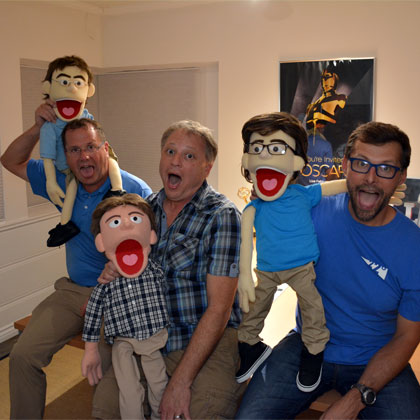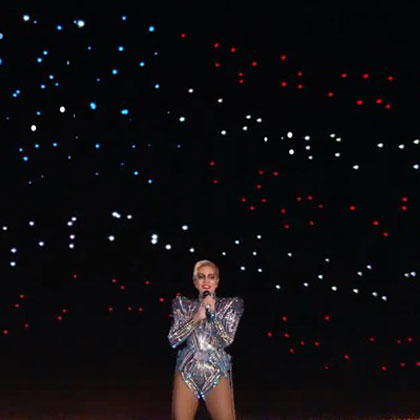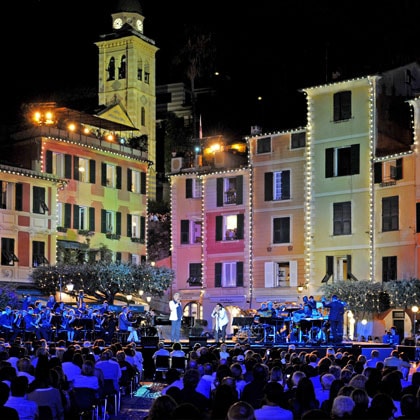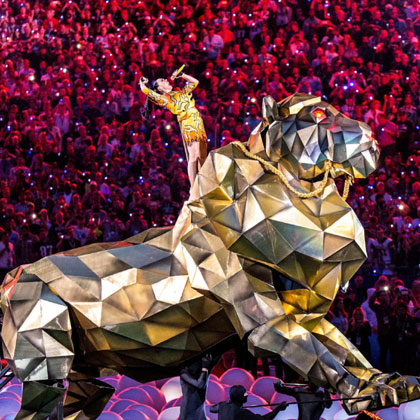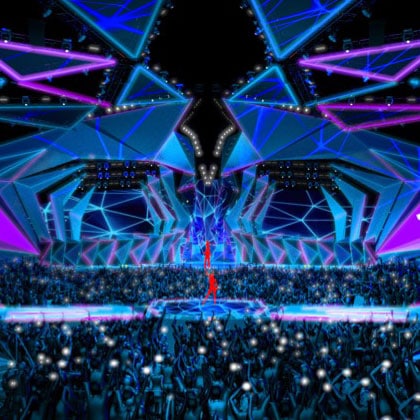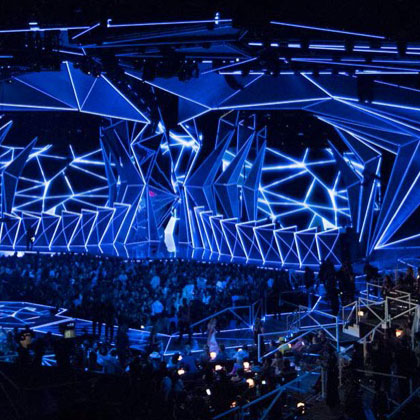
Through his 30+ years in the business, American LD Bob Barnhart has become the go-to guy for lighting the biggest live television broadcasts. From the glittering Oscars telecasts to the Super Bowl Halftime shows, and countless light entertainment, live music, national awards and fashion shows in between, Barnhart’s talents have made many show shine and brought him 11 EMMY Awards from an incredible 42 nominations. We spoke to Bob, now a founding partner of leading entertainment design collective 22 Degrees Inc., to find out more about careers, design, collaboration and technology . . .
Your career route has taken you right from the bottom rung of the ladder “doing grunt work” to the very top. Is that the best way in, or do you think formal education courses now provide better routes to success?
I started at California State University Chico and finished my undergrad time at California Institute of the Arts, so I would say I received a formal education. They say ‘When you graduate from college you graduate with the knowledge of what it is you need to go out and learn’. So the advantage of a more formal education is that you will learn on the job at a faster and more productive rate. Is it required? Not in my opinion, but I think the benefits outweigh the cost.
Of course, to have a successful “formal education”, you have to go into it like a 3 year-old and ask ‘why?’ until you understand and your professors are so tired of you, you can fail all of your classes and they will still give you a diploma, just to get rid of you! You are paying for the right to suck every bit of information out of that institution as humanly possible: if you go just to be “taught”, you are wasting your parents’ money.
What advice do you give to those who aspire to emulate your success?
I don’t like to assume that other people consider me successful. Let me give you two minutes of a one-hour lecture I give at colleges. First, I’ll give you my definition of success and we can work from that.
Choices = Control : Control = Success
No matter where you are in your career, year 1 or year 35, the more ‘choices’ you have for jobs, the more ‘control’ you have over the direction of your career, and therefore, I feel, the more successful you are. When you have choices, you can steer the direction you would like your career to be headed.
Every day of your career you are hired based on one thing: your reputation, which is what other people collectively think of you. The higher your reputation, the more choices you are going to get. You will find at the end of your time in this industry, that attitude, work ethic and personality will overshadow your skill set. At the professional level your skill set is expected. This is a longer conversation than we have time for here but in short, spend as much time on those three attributes as you do on your skill set.
You seem to have designed lighting for most types of show and performance, but have become especially sought-after for high-profile TV lighting. Was that deliberate?
That’s an interesting question. I’m not sure it was deliberate in the sense that I made a conscious choice to do “high-profile” shows. It was more of a conscious choice to work with designers, producers and directors that happened to be working on these types of shows. If we refer back to the previous question, I think I had choices and I used those choices to guide my career in the direction of people I liked working with.
What has changed for you since the formation of 22˚?
22 Degrees is a group of very like-minded people. So the fundamental change, is that we’re a company that I think supports its clients at a higher level and runs with a more efficient template.
What aspect of your work today at 22˚ do you most enjoy?
When we formed 22 Degrees we tagged the company name with ‘Entertainment Design Group’. We did this because we would like to be thought of as more than just lighting designers. We like to be as helpful to the entire production process as we can. So by contributing more to a show than just lighting ideas, I think we make ourselves more valuable to our clients.
Do you have any special career highlights? What achievements have given you the biggest buzz and why?
There have been many, many moments or shows I feel lucky to have been a part of. The list is long and I try never to forget it. One particular moment was the opening of Super Bowl 51 Halftime show with Lady Gaga. I had an idea to use Intel’s Shooting Star drones for the beginning of the Halftime show. Our producer, Ricky Kirshner, allowed me to develop the idea and once I had work out the ‘message’, staging and drone choreography, we presented it to Lady Gaga and the rest is history. It’s always a very difficult process when you are trying to do something very technical that has never been done before, especially in an environment like the Super Bowl. So that type of ‘highlight’ sticks with you.
Is there anything in your career you look back on as a low point or a failure?
Wow, yes, in short. I am not sure I can give you a specific example, probably because I try to block them out! There are many shows or moments in a show where I wish I could have a do-over. I’m not sure in our industry there are “failures” but there are certainly times where things could have been better. I try not to dwell on these things for too long. I think the best thing we can do is try to learn from them and then go play golf so you can be mad at something much less important!
Contributing to the design of big shows calls for high-level collaboration, with exceptional communication and understanding between disciplines. What techniques have you developed to ensure that this process runs as smoothly as possible?
I think this question could take a full semester to answer. First, let’s start with the beginning of your career: one of the reasons I would encourage a ‘young’ person to try and work with as many different people as possible and in as many job positions as possible, would be logical, is so that they gain an appreciation for all the departments they will be collaborating with. Let’s just take the relationship between a set designer and a lighting designer for a good example. We have to communicate about every single aspect of the production design. There needs to be a mutual appreciation for each other’s discipline. If we can break down every piece that will need to be lit and work through all of our solutions long before the set goes into the shop, the chances of a successful outcome have grown exponentially. So in short, the key is to appreciate the other departments’ challenges. Explain yours and give choices, ideas and solutions. One of my many mottos: ‘Be a problem solver not a problem identifier. We already have plenty of problem identifiers’ . . .
Do you think the advent of new and increasingly varied video technology is changing the landscape as far as the roles/responsibilities of design teams are concerned? If so, can you explain how?
We certainly have seen a massive increase in LED walls, floors and projection surfaces implemented in the production design of many or our shows. It poses a series of challenges and creative dynamics. Let’s take the 2019 Video Music Awards for an example: we had an enormous, diamond-shaped stage floor which was all LED product and a very large LED back wall. Simply from a lighting aspect, we need to be very vigilant about the output of all of these “loose lumens”. It literally lights up the entire room and therefore challenges you to regain a contrast ratio that is theatrically pleasing. Some of this will be contained with dialling down the intensity of course, but most of it will have to come from the content itself.
This brings us to our next challenge: working with the content creators. Every production is a unique experience, because the creative process is different for almost every show. The content company might be getting its direction from the “talent” or the production designer. So the lighting department has to figure out how to dance with many different partners. A good content company will be in constant communication with the lighting team. Our two looks need to become one cohesive approach, by the end. The reality is, that it is harder to create content and get it approved in a timely manner than it is for us, so I find myself chasing their color palette more than dictating from our department.
In my personal opinion, I think too many shows use these devices as a crutch to support their creativity. It’s perfect for the VMAs, because it’s the VIDEO Music Awards. Then, just when you thought you were getting a handle of video technology being added to your shows, we are now starting to battle AR - Augmented Reality. This is posing a whole new hurdle for the lighting department!
Your role has expanded into overall production design for recent seasons of So You Think You Can Dance? How do you enjoy that expanded responsibility?
As I said before, we like to be as valuable to the production as possible, but that does not mean we necessarily want to be set designers. So You Think You Can Dance? was looking for a new set for season 12 and the lighting department had an idea for it. The idea came from the desire to have as many alternative looks as possible.
When you do a series like this, you end up doing about 100 different dances in a season. So the more flexible everything can be, from the set to the light plot, the more diverse the show will be. The concept was a set that we could project gobos on and give lighting a large creative canvas, but which could also go away when we wish and allow us to live in a less recognizable environment.
Anything we can do to help tell the story of that dance is what we strive for. So what we enjoy about the set on So You Think You Can Dance? is the creative flexibility. Taking this on hasn’t made the job harder, it’s actually made it easier and much more effective. Although it did take away the ability to blame the set designer!
What traits do you admire most in the creatives you collaborate successfully with?
I think the willingness for everyone to be open to new ideas. Don’t try to be different just to be different, but be willing to try something that might seem difficult because there is no obvious solution at that moment. I think it’s fun when you are close to show day and you can hold up the production designer’s rendering with the actual set in the background and see that you were able to realize their vison in reality. I’ve always liked to look at problems, as opportunities to come up with cool solutions. We are not here to tell production “no” – we’re here to tell them what it will take to make “yes” happen.
When you approach a new design, do you think in terms of specific lighting fixtures, or do you think just in terms of the desired effect / performance?
I first want to understand the show. Once I think I understand the basic concept - Super Bowl Halftime show, So You Think You Can Dance, Andrea Bocelli in Portofino Italy - then the next thing I need to understand is the production design / set / environment. Super Bowl - I know I need to show scale, fill the stadium with light to give it volume. So You Think You Can Dance – I’ll be looking for ‘workhorse’ light fixtures, like a big Swiss army knife! Bocelli in Portofino – I’m looking to light the entire town but make it look natural and with no lighting instruments to be seen. So I guess the short answer is “effect/performance” first, then think about what fixture would achieve that.
How do you like to keep up with technological developments in stage lighting technology (and equally in TV cameras and video processing, for example)? Do you read the press, or attend trade shows etc?
I feel very fortunate to have a good relationship with most of the manufactures. We are always talking what’s next and what are we looking for. Also with the advent of the internet (yes, there was a time before the internet!), I think it’s much easier for all of us to keep up with what’s new.
What are the main performance characteristics you look for in a luminaire?
Flat field, consistent color temperature, consistent light output and as reliable as possible. After that, as many tools as possible. Shutters, iris, gobos, effect wheels, zoom ratio, color flexibility. You know - everything!
In terms of the LD’s current lighting toolkit, what’s missing? Is there anything different you would like to see from manufacturers?
I think we are seeing a great leap forward in lighting equipment coming to the market. With the advent of optically harnessing LED engines and a large variety of LED products, we have been given many new choices in the last five years or so, although I by no means think we have hit some end-point.
However, I would like to see some additional focus put on more robust and redundant networking systems. These shows are becoming large, angry animals and we need to make sure we keep these systems online.
The other focus I would like to see is getting every fixture IP-rated. I would love to get to a point where it’s not even a conversation anymore. I know right now that seems difficult, but everything that has never been done before seems difficult at first. I have very little doubt that this is possible, or that it would be much better for our industry.
You recently spec’d 80 LED-based VL2600 Profile fixtures on So You Think You Can Dance – a significant commitment to LED sources. What do you think of the current state of LED-based stage lighting on the market?
Well, in full disclosure, I have spec’d the VL2600 on most shows since I used some demo units on the 2018 MTV Video Music Awards. Since then, I have tried to use only LED spot/profile fixtures on all of my shows.
Starting about six years ago, I gravitated away from traditional wash fixtures, as I was finding that as the optics were getting better and better, that a spot-style fixture gave me a lot more tools ‘per foot’. What I mean by ‘per foot’ is, if we use the theory that I can afford a light every 6ft on my electrics, I would much rather have a light that can do five different things, than one.
With the optics of a light like the VL2600, I can make it a wash fixture or a spot fixture, as I need to. So LED stage lighting is here to stay, until something better takes it over. Each time a new hurdle is passed, the bar has been raised and “we” are not willing to go backwards. The flat field and consistent color temperature of these new LED fixtures is like discovering good wine or flying in business class: the previous alternatives becomes unpalatable.
How far is low power consumption a consideration for you?
To be honest, it had better become very important for all of us - not just the lighting industry. With regard to the lighting industry, I think it is significant: to be able to lower our power draw becomes an expediential positive for the entire production. Although LED is not void of producing heat, it by no means generates the amount of heat that an equivalent lighting rig would have done a decade ago. So now, in addition to drawing less power, we are also not requiring venues to run as much A/C as we have in the past.
You’ve designed many shows that most people would consider to be their ‘dream gig’ - with the biggest stars and the biggest TV audiences - but do you have an as-yet-unfulfilled dream gig?
It’s such a simple question, yet I’m at a loss for a good answer. We used to joke that we wanted to do a swim-suit show on an exotic island. Then years later we did the Victoria’s Secret Swimsuit Special for three years on three different islands (check).
I like to be challenged and I like to develop things that I have not seen yet, but wish I had. My first patented invention was the Pinsplitter, then the Handle, more recently the lighting team from So You Think You Can Dance was instrumental in developing the Ground Control remote followspot fixture. So, I think in some ways my dream gigs are things I haven’t done before. I do think some of these high-end fashion shows could be fun projects or maybe a Broadway musical - but then my other lighting designer friends would not like me playing in their sandboxes . . . That might be bad, as I like my personal reputation in the industry more than my professional career!
